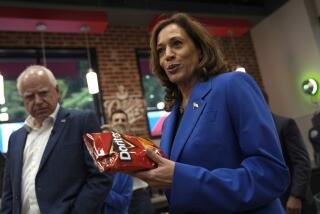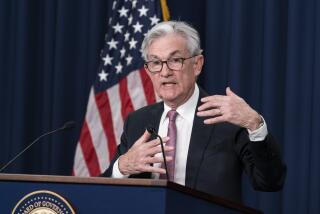Higher Prices Bring Curses, Cheers, Danger
Why all the sudden talk about inflation? Ever since Alan Greenspan was called in from the bullpen to relieve Paul Volcker as chairman of the Federal Reserve Board this week, the big question among the experts has been: Will Greenspan will be as tough on inflation as Volcker?
But what inflation? Prices in the U.S. economy rose less than 2% last year. Admittedly, they may rise 5% this year, but even that doesn’t seem cause for alarm if you think about the reasons. The price of oil has bounced back from its decline of last year to $18 a barrel from under $12. But nobody sees it going much higher soon. And the dollar’s fall against other currencies has pushed up the prices of things we import.
But like the oil-price bounce, the dollar’s fall is a one-time thing. There seems to be no threat today of a return to 1970s inflation, when prices rose 14% a year and interest rates got so high that only 5% of the population could qualify for a home mortgage.
Mixed Bag
So why the talk? Because people are bewildered at the moment, divided between worrying about inflation and welcoming it. And that makes sense. Because inflation hurts on the one hand, but helps on the other, and it is doing moderate amounts of both right now.
You don’t often hear inflation--using the word, as it’s most commonly understood, simply to mean rising prices--described as a help. But anybody in business knows it can be. “It’s an old economic dictum that a small amount of inflation is beneficial to economic growth,” says James Cochrane, economist at Houston’s Texas Commerce Bank. Cochrane doesn’t have to look far to find beneficiaries. Borrowers in Texas who have loans on commercial real estate, for example, would cheer if general inflation raised price and rent levels. They could then get more money into their hands to pay back their loans, which would not have increased, with so-called cheaper dollars.
The federal government plays that game, in fact--making payments on the national debt or the debt to foreigners by cheapening the currency rather than raising taxes.
But you don’t have to be a borrower. Businesses everywhere know that a little inflation turns inventories into profit centers as the raw materials you stock in May become more valuable in June. And it’s easier to raise prices in time of inflation because the competition is doing the same.
Orders Rolling In
U.S. business’ foreign competitors are raising prices these days, and that’s leaving openings for the domestic side. In the Pennsylvania-Ohio industrial belt, reports economist Lee Hoskins of the Pittsburgh National Bank, the steel and chemical industries have strong order books and are finding they can lift prices a little. In North Carolina, Executive Vice President Richard Roberts of the First Wachovia banking company says textile industry order books are filling up.
Farmers, too, are finally starting to see rising prices, says economist Richard Peterson of Chicago’s Continental Illinois Bank. The price rises may reflect American farm products becoming competitive due to currency shifts more than fundamental world supply-demand conditions, but prosperity-starved farmers don’t argue. Just as homeowners seldom argue when the house down the street sells at a new high price.
But there are losers, too. Wage earners right now are facing higher prices at the grocery store, but their pay isn’t keeping pace. Pay levels in the economy have risen 2.6% so far this year, while prices have gone up 5%.
Global competition is hurting them. “Real wages are declining in response to international competition,” says economist Albert M. Wojnilower of First Boston, the investment bank. Annoying as that may be, the alternative of no inflation might mean a cut in wages as some companies suffer from depressed prices. Cleve Anschell, economist for Rainier Bank in Seattle, reports that inflation is mild in the Pacific Northwest because workers in major industries like forest products and shipbuilding have been forced to take pay cuts.
So business and farmers and borrowers all benefit, and wage earners pay the bill with a drop in their purchasing power. And when wage earners are also homeowners or borrowers, they benefit, too.
False Impression
What’s the big danger in inflation? That’s like drinking and driving, it gives the illusion of competence at high speed. Easy profits lead companies to misjudgments about expanding the business, employees in a quickening economy demand and get higher wages and the inflationary spiral gets steeper.
Some economists, such as David Levine of the Sanford C. Bernstein research firm, see the economy heating up this year and into the election year 1988. That’s a minority opinion among economists, to be sure, and we are unlikely for many reasons to get back to the 14% of the 1970s. But anything over 6% inflation creates distortions in the economy, which are followed by a correction--sometimes called a recession. The last time the economy needed to take the recession cure, it called on Volcker. Let’s hope it doesn’t have to make the same demand of Greenspan.
More to Read
Inside the business of entertainment
The Wide Shot brings you news, analysis and insights on everything from streaming wars to production — and what it all means for the future.
You may occasionally receive promotional content from the Los Angeles Times.










